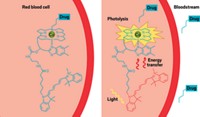Advertisement
Grab your lab coat. Let's get started
Welcome!
Welcome!
Create an account below to get 6 C&EN articles per month, receive newsletters and more - all free.
It seems this is your first time logging in online. Please enter the following information to continue.
As an ACS member you automatically get access to this site. All we need is few more details to create your reading experience.
Not you? Sign in with a different account.
Not you? Sign in with a different account.
ERROR 1
ERROR 1
ERROR 2
ERROR 2
ERROR 2
ERROR 2
ERROR 2
Password and Confirm password must match.
If you have an ACS member number, please enter it here so we can link this account to your membership. (optional)
ERROR 2
ACS values your privacy. By submitting your information, you are gaining access to C&EN and subscribing to our weekly newsletter. We use the information you provide to make your reading experience better, and we will never sell your data to third party members.
Materials
Nanoparticles Release Drugs On Demand
Drug delivery: Zapped with ultraviolet light, polymer particles shrink
by Jeffrey M. Perkel
March 13, 2012

Many chemists think encapsulating cancer drugs inside nanoparticles could lead to more efficient and specific drug delivery. But these nanoparticles often struggle to penetrate inside a tumor or to release their drug payloads once they’re in place. Now researchers demonstrate a solution to both problems using polymer nanoparticles that expand and contract when excited by certain wavelengths of light (J. Am. Chem. Soc., DOI: 10.1021/ja211888a).
Daniel Kohane and his colleagues at Children’s Hospital Boston thought that a nanoparticle whose size changed on command would allow them to maximize the amount of drug they could load into the particles. They thought such a particle would also be small enough to squeeze through the extracellular matrix inside a tumor. Also upon shrinking, the particles would release the loaded drugs, like a squeezed water balloon.
To make such nanoparticles, the researchers use two materials: lipid-decorated versions of the polymer polyethylene glycol, and the photoactive molecule spiropyran to which they added long alkyl groups. When the researchers mix the materials with a small molecule such as a drug or fluorescent dye, the components assemble into particles that are about 150 nm in diameter. If they apply a pulse of ultraviolet light, spiropyran converts into a more-hydrophilic molecule called merocyanine. This chemical transformation causes the particles to shrink to about 40 nm in diameter. In visible light or in the dark, the reaction reverses, restoring the particles to the larger volume.
To test the nanoparticles’ ability to release drugs, the scientists placed dye-loaded particles in buffer and measured how much dye diffused into the liquid. In the absence of ultraviolet light, the spiropyran-based particles slowly bled out the payload, releasing about 7% of the total contents in an hour. But after the researchers hit the mixture with a 30-second pulse of UV light, the particles dumped about 29% of their contents within an hour. The team could repeat the drug-release spike by allowing the particles to expand for three hours and irradiating them with UV light again.
To see how well the particles could squeeze into tight spaces, the researchers added dye-loaded nanoparticles to one end of a capillary tube filled with collagen gel and watched the dye diffuse along the tube. The gel, they reasoned, mimicked the tight spaces in a tumor’s extracellular matrix. A 10-second pulse of UV light increased diffusion of the dye-containing particles through the gel by almost 50% compared to non-irradiated particles, from 8.3 to 12.1 mm, suggesting they also could penetrate deeper into biological tissues.
Kohane says the new particles could allow physicians and patients to control when or where drugs are released, like nanoscale patient-controlled morphine pumps. Now the researchers want to show that the nanoparticles are safe and effective in animals.
Warren Chan of the University of Toronto says using light to control nanoparticle size offers “a unique twist” on drug delivery. But he points out that neither UV nor visible light penetrates mammalian tissues effectively. As a result, he says, the researchers should tweak their design to respond to more biologically relevant near-infrared wavelengths.




Join the conversation
Contact the reporter
Submit a Letter to the Editor for publication
Engage with us on Twitter